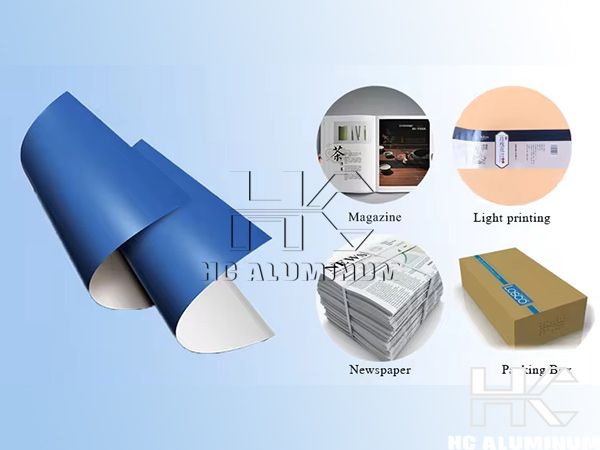
News
CTP (Computer-to-Plate) plates are the key carriers of offset printing, and their performance directly affects printing quality, efficiency and cost.

According to the platemaking principle, CTP plates are mainly divided into two categories:
- Principle: The plate coating is heated by thermal laser (wavelength around 830nm) to make the image part undergo physical or chemical changes, forming an oleophilic surface, while the non-image part remains hydrophilic.
- Features:
Not sensitive to ambient light, can be operated in a bright room, and reduce the investment in darkroom equipment;
High printability (usually 100,000 to 500,000 prints), suitable for long-run printing (such as books, periodicals, and packaging mass production);
High platemaking precision (resolution can reach 2500~4000dpi), supporting 175~300 lines/inch fine dots.
- Applicable scenarios: long-run printing, high-precision images (such as commercial brochures, packaging color printing), complex orders that require frequent machine debugging.
2. Violet CTP Plates
- Principle: Use violet laser (405nm wavelength) to expose the plate coating to photochemical reaction, and form a graphic area after development.
- Features:
The plate making speed is fast, suitable for short-run printing (within 100,000 prints);
The cost is low, and the unit price of the plate is about 60%~80% of that of the thermal plate;
It is sensitive to ambient light and requires darkroom or semi-brightroom operation, and has high requirements for developer management.
- Applicable scenarios: short-run printing (such as leaflets, personalized printing), small and medium-sized printing plants with limited budgets, and urgent orders with high requirements for plate making speed.
When selecting a CTP plate for offset printing, it is necessary to combine printing needs, equipment conditions and cost targets, and focus on evaluating the following indicators:
1. Printing life: matching the number of prints
- Short-run printing (<50,000 prints): choose low-printing life plates (such as economical photosensitive plates) to reduce the cost per plate;
- Medium-long prints (50,000 to 200,000 prints): thermal plates or photosensitive plates with optimized printing life (such as pre-baked plates);
- Extra-long prints (>200,000 prints): high-printing life thermal plates (such as after baking), or metal-based reinforced plates (such as titanium alloy composite plates).
- Note: Insufficient printing life will cause plate wear and dot distortion, requiring frequent plate changes, which will increase downtime costs.
2. Resolution and dot reproduction capability
- Fine printing (such as packaging, anti-counterfeiting labels): resolution ≥ 2500dpi, dot reproduction accuracy of 1%~99%, thermal plates or high-resolution photosensitive plates (such as Fuji VIVACE series) are preferred;
- Ordinary printing (such as books, newspapers): 1500~2000dpi resolution is sufficient, photosensitive plates are more cost-effective.
3. Plate compatibility: matching with inks and equipment
- Ink type:
UV ink: UV-curing-resistant plates must be selected (such as positive thermal plates, with chemical-resistant coatings);
Water-based ink: Ordinary thermal/photosensitive plates are acceptable, but attention must be paid to the stability of the hydrophilic coating of the plate.
- CTP equipment:
Thermal plates need to be matched with thermal laser platemakers (such as Kodak ThermoFuse series);
Photosensitive plates need to be matched with violet laser platemakers (such as Heidelberg Suprasetter A75). Pay attention to the matching of the equipment wavelength and the plate's photosensitive band (such as 405nm laser for photosensitive plates).
4. Environmental protection and processing costs
- Process-free plates: No developer is required, direct plate making reduces waste liquid treatment costs, suitable for scenes with high environmental protection requirements (such as the European market), but the unit price of plates is relatively high;
- Traditional plates: Need to be developed and washed, and need to be equipped with a waste liquid treatment system, suitable for areas with low environmental protection requirements.
5. Cost and cost performance
- Short-term cost: photosensitive plate (about 0.5~1 yuan/square meter) < thermal plate (1~2 yuan/square meter) < processing-free plate (2~3 yuan/square meter);
- Long-term cost: in long-run printing, thermal plate has high printing durability and lower cost per print (for example, for 200,000 prints, the cost per thermal plate is diluted to 0.01 yuan/print, while the photosensitive plate may need to be replaced 2~3 times).
Plate selection strategies for different industries
Industry/Scenario | Printing demand characteristics | Recommended plate types | Core indicator priority |
Packaging printing | High resolution, multiple spot colors, long version | Thermal positive plate (baking plate treatment) | Printing durability > Resolution > Ink compatibility |
Commercial printing (picture albums, posters) | High-precision dots, short or medium version | High-resolution photosensitive plate or thermal plate | Resolution > Plate making speed > Cost |
Books, newspapers | Medium version, low cost, mainly text | Economical photosensitive plate | Cost > Plate making speed > Printing durability |
Label and anti-counterfeiting printing | Fine dots, UV ink, friction resistance | UV-resistant thermal plate (metal-based coating) | Ink compatibility > Printing durability > Resolution |
Personalized printing (small batch) | Short version, fast plate making | Process-free thermal or photosensitive plate | Plate making speed > Cost > Printing durability |
Common selection misunderstandings and solutions
Misunderstandings 1: Blind pursuit of high printability
Consequences: Selecting low printability plates for long-run printing leads to frequent plate changes; selecting high printability plates for short-run printing leads to cost waste.
Solution: According to order history data, calculate the average number of prints, and select the printability range according to "number of prints × 1.2 times".
Misunderstanding 2: Ignoring equipment compatibility
Consequences: Thermal plates cannot be exposed when paired with purple laser equipment; photosensitive plates are not matched with the correct developer, resulting in the scrapping of plates.
Solution: Confirm the CTP equipment model and laser wavelength before purchase, and consult the plate supplier whether they provide equipment compatibility testing.
Misunderstanding 3: Ignoring environmental factors
Consequences: Photosensitive plates are operated in a bright room, resulting in a high scrap rate; plate coatings are damp in a humid environment, affecting hydrophilicity.
Solution: Thermal plates can be operated in a bright room, suitable for scenes with strong light in the workshop; photosensitive plates need to be equipped with a darkroom or UV-proof lampshade, and the storage environment humidity is controlled at 40%~60%.
Quality control method
1. Sample testing process
Take 5~10 plates for testing: check the edge clarity of the dots, scratch resistance (scratch the coating lightly with a fingernail, no shedding is qualified), and the cleanliness of the plate base after development after plate making.
2. Establish a quality feedback mechanism
Record the scrap rate and printability attenuation node of each batch of plates, and communicate with suppliers regularly for optimization.
Future trends: digitalization and environmental protection upgrades
- Popularization of unprocessed plates: With the tightening of environmental protection regulations, unprocessed thermal plates (such as Kodak unprocessed plates) will become mainstream, reducing the use of chemical agents;
- Intelligent platemaking integration: Some plate suppliers have launched solutions that are linked to the printing ERP system, automatically recommending the type of printing plate based on order parameters, and reducing manual selection errors.
The selection of CTP plates for offset printing should be based on "printing needs as the core and cost and quality balance as the goal". By breaking down the dimensions of printing, precision, ink, equipment, etc. and combining practical scene experience, efficient selection can be achieved. It is recommended that printing plants establish a printing plate selection manual, classify matching solutions by order type, and pay attention to technology iteration to optimize production costs in digital transformation.
PRODUCTS
ONLINE CONSULTATION
If you have any questions, please contact us and we will contact you as soon as possible.
Leave A Message
If you are interested in our products and want to know more details, please leave a message here, we will reply you as soon as we can.

